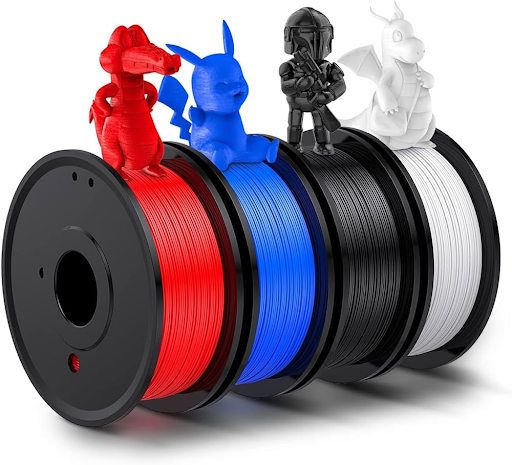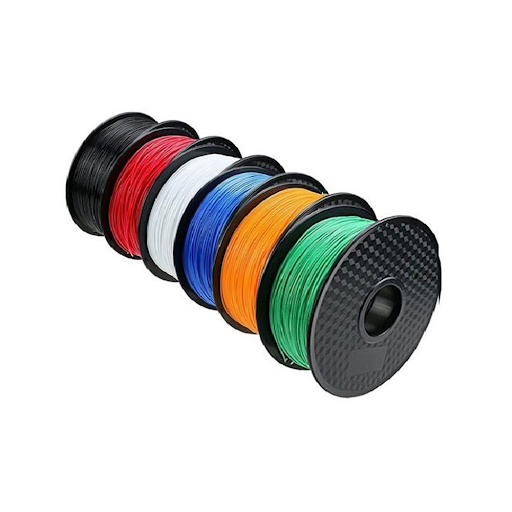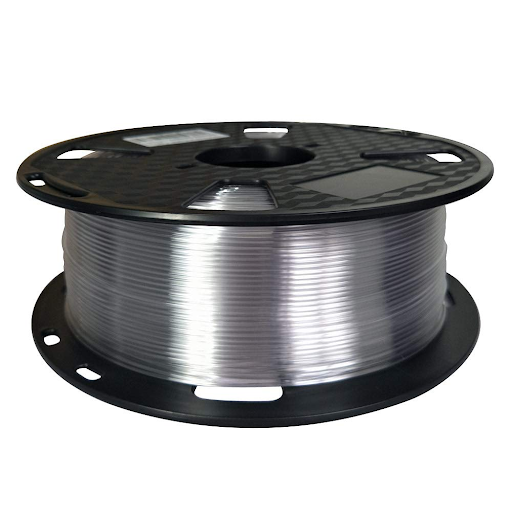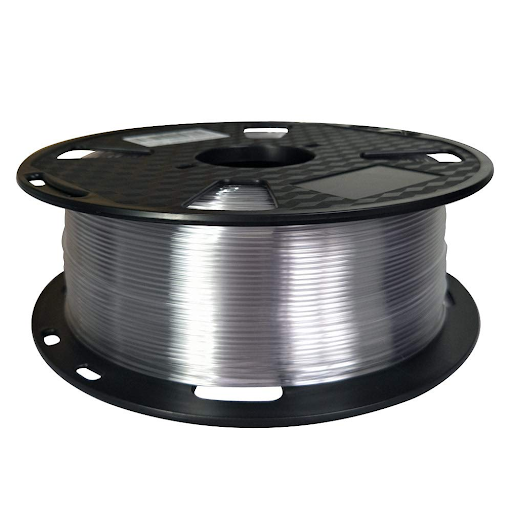Welcome to the world of 3D printing with the Ender series! If you're a proud owner of an Ender 3D printer, you know that the quality of your prints largely depends on the filament you choose.
In this comprehensive guide, we'll explore the best filaments for your Ender printer, ensuring that you're well-equipped to bring your 3D creations to life.
From the versatile PLA to the robust PETG and even the challenging ABS, we've got you covered. Let's dive into the exciting world of filament selection.
Understanding Filament Types

Different color 3D filaments and 3D models. Image source: Amazon
Before we delve into the specific filaments ideal for Ender, let's gain a deeper understanding of the primary filament types used in 3D printing.
- PLA Filaments
Polylactic Acid (PLA) filament is the go-to choice for many Ender users. It's renowned for its ease of use and versatility.
PLA is a biodegradable thermoplastic derived from renewable resources like corn starch or sugarcane. It boasts several key advantages, including minimal warping, low odor during printing, and a wide range of vibrant color options.
PLA is also known for its excellent layer adhesion, making it an ideal choice for beginners and experienced 3D printing enthusiasts alike.
- PETG Filaments
When strength and durability are paramount, Polyethylene Terephthalate Glycol (PETG) filaments step in to deliver exceptional results.
PETG filaments are known for their toughness and resistance to impacts and moisture. These filaments combine the best attributes of both PLA and ABS, making them an excellent choice for a wide variety of projects.
With good layer adhesion and reduced brittleness compared to PLA, PETG is often chosen for functional parts, mechanical prototypes, and objects that need to withstand some wear and tear.
- ABS Filaments
Acrylonitrile Butadiene Styrene (ABS) filaments are prized for their heat resistance and durability.
ABS is known for its ability to withstand high temperatures, making it suitable for applications that require resistance to heat and chemicals.
It is commonly used in automotive parts, enclosures, and mechanical components. However, it's worth noting that ABS can be more challenging to print due to its tendency to warp, so it's recommended for users with some 3D printing experience.
- Specialized Filaments
Beyond the basics, there's a world of specialized filaments waiting to elevate your 3D printing projects.
Specialized filaments include Thermoplastic Polyurethane (TPU), Nylon, and wood-infused filaments. TPU offers excellent flexibility, making it suitable for items like phone cases and shoe soles. Nylon, on the other hand, is known for its durability and is often used in engineering applications.
Wood-infused filaments add a unique aesthetic, mimicking the appearance and even the scent of real wood.
Best Filaments for Ender: PLA

Different roles of 3D printing PLA filaments. Image source: Olectronics
Now that we have a solid grasp of filament types, let's dive into the details of the best filaments for the Ender, starting with PLA.
PLA is the filament of choice for Ender users who prioritize ease of use, versatility, and aesthetics.
- Hatchbox PLA
Hatchbox PLA is a household name in the 3D printing community, known for its consistent quality and reliability. It comes in many colors, allowing you to unleash your creativity. With minimal warping and excellent layer adhesion, Hatchbox PLA is an excellent choice for Ender users of all skill levels.
- Overture PLA
Overture PLA filaments are renowned for their vibrant and true-to-color prints. They are manufactured with precision, ensuring a smooth and hassle-free printing experience. Whether you're creating intricate models or functional parts, Overture PLA delivers outstanding results.
- eSUN PLA+
eSUN PLA+ is an upgraded version of standard PLA, offering enhanced toughness and impact resistance. This filament is known for its minimal stringing and warping, making it a favorite among Ender users. The added strength makes it suitable for a wide range of applications.
Best Filaments for Ender: PETG


Silver color PETG filament rounded in a black roller. Image source: Amazon
Moving on to PETG filaments, which are celebrated for their strength and durability.
When you need robust and resilient prints, PETG is the filament of choice for your Ender.
- eSUN PETG
eSUN PETG filaments are renowned for their reliability and strength. They exhibit excellent layer adhesion, reducing the risk of delamination. This filament is suitable for functional prints, mechanical parts, and prototypes that need to withstand the test of time.
- Overture PETG
Overture PETG filaments are engineered to provide the perfect balance between strength and flexibility. They are less prone to warping compared to ABS and offer exceptional layer bonding. Whether you're printing architectural models or mechanical components, Overture PETG can handle the job.
- Sunlu PETG
Sunlu PETG filaments are known for their consistent diameter and minimal print odor. They offer good transparency, making them suitable for applications where aesthetics matter.
Sunlu PETG is easy to print with, even for those new to PETG, making it a great choice for Ender users looking to explore this material.
Best Filaments for Ender: ABS and Beyond
ABS filaments are prized for their heat resistance, making them ideal for applications where other filaments might fail. Let's explore some top ABS options for Ender, as well as other specialized filaments.
ABS filaments are the choice for Ender users in need of prints that can withstand high temperatures and tough conditions.
- eSUN ABS+
eSUN ABS+ offers improved toughness and reduced warping compared to standard ABS. It is engineered for excellent layer bonding and minimal shrinkage during cooling. This filament is a reliable choice for Ender users seeking the benefits of ABS without the common challenges.
- Polymaker PC-Plus
Polymaker PC-Plus is a polycarbonate-based filament known for its exceptional strength, heat resistance, and optical clarity.
While it's a bit more challenging to print than PLA or PETG, it's worth the effort for applications that demand these properties. It's commonly used in engineering and aerospace projects.
- Specialized Filaments
When your 3D printing projects require a unique touch, consider specialized filaments. TPU filaments offer flexibility and are ideal for creating rubber-like parts.
Nylon filaments provide high strength and durability, perfect for gears and functional prototypes. Wood-infused filaments add a natural aesthetic to your prints, making them suitable for artistic and decorative items.
Choosing the Perfect Filament
Now that we've explored the best filaments for your Ender, let's discuss how to make the right choice for your specific projects.
Selecting the perfect filament involves considering factors like print temperature, project requirements, and budget.
- Print Temperature
Different filaments have different print temperature requirements. Ensure your Ender printer can reach the necessary temperature for your chosen filament.
PLA typically prints at lower temperatures (around 190-220°C), while PETG and ABS require higher temperatures (around 230-250°C for PETG and 220-250°C for ABS).
- Project Requirements
Consider the intended use of your 3D-printed objects. Do they need to withstand physical stress, high temperatures, or exposure to chemicals? Choose a filament that aligns with your project's requirements.
- Budget Considerations
Filament prices can vary significantly. While some premium filaments offer enhanced properties, there are also budget-friendly options that provide good results for hobbyists and casual users. Assess your budget and project needs to find the right balance.
Where to Buy the Filament
To get started with your filament selection, you'll want to purchase from reputable sources. You can find a wide range of filaments, including the ones mentioned in this guide, from online retailers, local 3D printing shops, or the manufacturers' websites.
Best 3D Printing Software
There are many 3D printing software software but we recommend using SelfCAD. SelfCAD offers an integrated and user-friendly design environment that caters to both beginners and experienced users. Users can easily create 3D models using a variety of tools and features, making the design process accessible to those with limited experience in 3D modeling. The software also provides tutorials and many educational resources, facilitating a smooth learning curve for users looking to master the art of 3D design.
In addition to 3D modeling tools, the software also comes an online slicer that is useful in generating the Gcode to send to your 3D printer. The video below shows how to slice your 3D models in SelfCAD.
[Embed this video: https://www.youtube.com/watch?v=lpf38aMk8d8&t=70s ]
Selecting the Suitable Filaments for Your Ender Printer
Choosing the best filament for your Ender 3D printer is a crucial step in achieving high-quality 3D prints. Whether you opt for the ease of PLA, the strength of PETG, the heat resistance of ABS, or explore specialized filaments, your choice will significantly impact your printing experience.
Remember to consider factors like print temperature, project requirements, and budget to make an informed decision.
With the right filament in your arsenal, your Ender printer will continue to bring your 3D creations to life with precision and reliability. Happy printing!

No comments yet